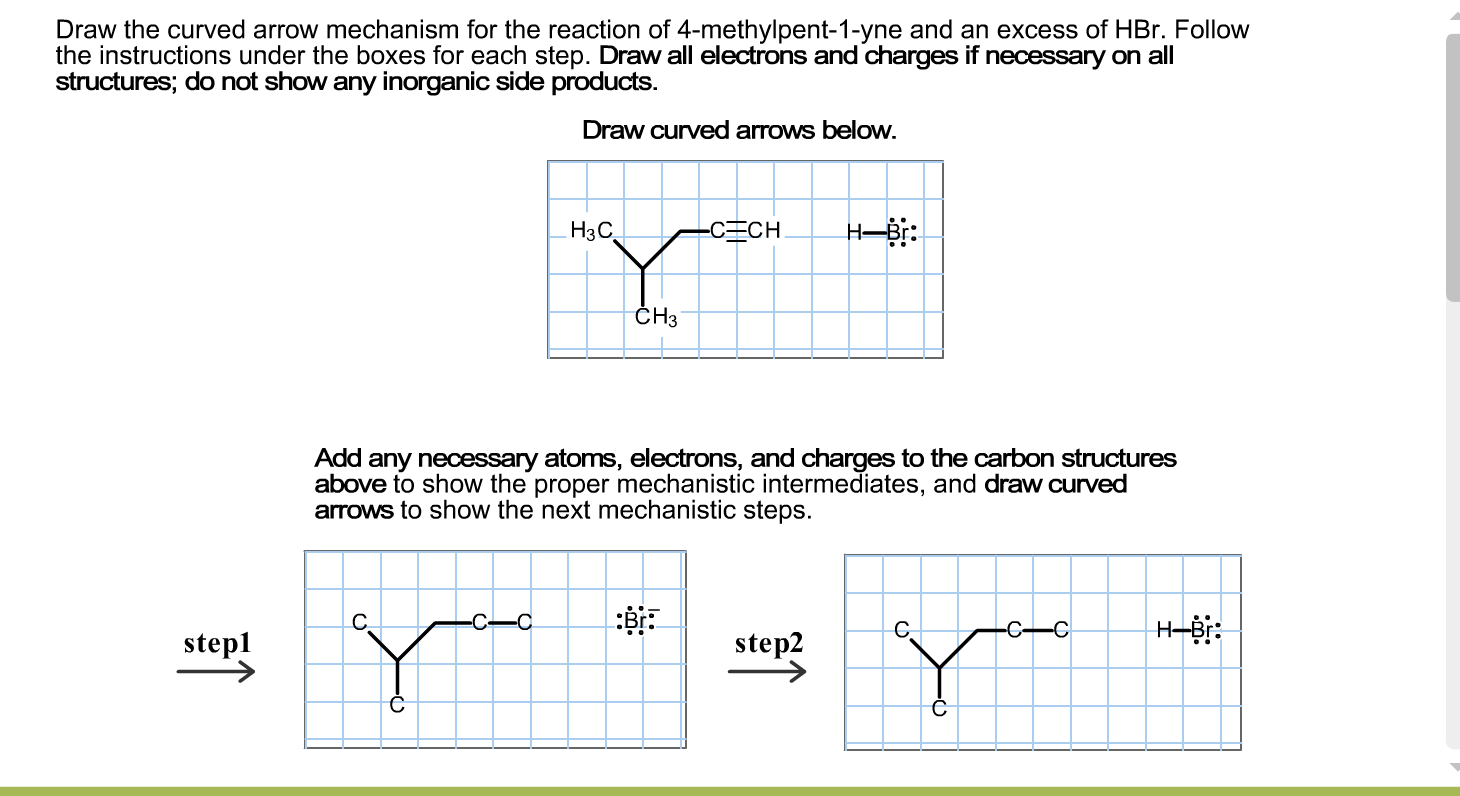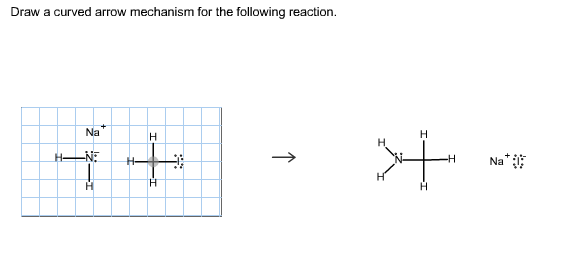The arrows only show atom movement indirectly as a consequence of electron movement when covalent bonds are made and broken. This is shown by drawing a curved arrow from the carbon-chlorine bond to the chlorine giving it a lone pair.

Solved Draw A Curved Arrow Mechanism For This Reaction Show Chegg Com
Draw a curved arrow mechanism for each reaction.

. This means that resonance structures. Draw a complete step-wise curved arrow mechanism for each reaction shown below. You dont need to worry about stereochemistry for these problems.
Electron flow is indicated with curved arrow. NaI 3 3 Cl KCN DMSO CN Br NaOH H2O heat BrH 2O OH I CH3CH2O-Na ethanol HI NaSH DMSO HSH Br HO KOH DMSO OTs NaNH2 NH3 TsO NH3 H2N O O CH CH3 TsO acetone O O CH CH3 I SN2 E2 SN1 SN2 E2 SN2 E2 SN1 SN2. Using the drawing window draw a structural formula or formulas for the compounds or ions formed by this mechanism.
ICI Aromatic iodination can be carried out with a number of reagents including iodine monochloride ICI. FREE Expert Solution We will assume that the reaction proceeds as written. If more than one reaction product must be drawn use the.
In this reaction the carbon-chlorine σ bond is cleaved and the bond electrons become a lone pair on the chlorine. 1 Find the nucleophile and the electrophile. Using the drawing window draw a structural formula or formulas for the.
The big difference between these two is that in resonance structures the connectivity of atoms stays the same. You only need to explain the products pictured in the scheme. Select a problem from the list on the right.
Arrows are never used to indicate the movement of atoms directly. It may help if you take the following steps. There will be a total of three curved arrows one of which is drawn for you.
As carbon can have a maximum of four bonds another bond on the carbon must be broken. Draw the product of the following reaction by following the curved arrows. And I make sure to draw it curly you will always see the curly like this.
Arrow-pushing Instructions CI HÃj. View Key_OPpdf from CHEM 101b at City College of San Francisco. We have already used arrow pushing to show proton transfer several times in Chapter 4.
The reaction shown takes place in four steps. Given the following single-step reaction draw the curved-arrow mechanism. When the Show Problem button is pressed a curved arrow mechanism will be shown below.
1 There should be two curved arrows. Radicals are chemical species which have an unpaired valence electron on an atomThis is different from what weve seen for polar reactions where electrons are always paired either in lone pairs or in covalent bonds. And you will see a curly half arrow that looks like this curly half arrow or fish hook arrow.
--- H H N Na. 2 Determine the major functional group present in the nucleophile and electrophile. Draw the products of the reaction shown.
Movement of pairs is the convention. Evaluating Curved Arrow Mechanisms. Submit Answer Try Another Version 1 item attempt remaining.
Solution for Draw a curved arrow mechanism for the reaction shown. For Each Of The Following Chemical Reactions Determine Their Reaction Mechanism As Either S1 SN2 E1 Or E2 That Gives The Major Product Shown. Your mechanisms must account for all products.
The first one is their use is resonance structures and the second is their use in demonstrating the mechanisms of organic reaction. This is because there is. Given the following single-step reaction draw the curved-arrow mechanism.
6 Draw a plausible curved arrow mechanism for the reaction shown below being from CHEM 368 at The University of Tennessee Knoxville. Complete the mechanism by adding curved arrows for each step and drawing the structures of the intermediates in the boxes. View Draw the major organic product of the reaction shown below.
For some of these reactions there may be other possible products that are not shown. One bond formed base grabbing the proton one bond broken the acid releasing the proton 2 The arrows should flow in the same direction. Select Draw Rings More Erase C H 1 Na N H H Na N CH 1 H H N.
Your mechanism must account for all products shown. Draw curved arrows to show the movement of electrons in this step of the reaction mechanism. How to Draw a Curved Arrow Mechanism in Organic Chemistryorganicchemistry reactionmechanism curvedarrowCurved arrows used by organic chemists to show rea.
Select a problem from the list on the right. Draw a curved arrow mechanism for the reaction shown. Select Draw Rings More Erase H Na H.
E NaOCH-CH Ethanol NaNH OTS NH Curved Arrow. The value of Δ H for the reaction is 75 k J m o l and the value of Δ S is 54 J K m o l. Additional instructions will be given in the information window.
Add any missing lone pairs that are involved in the mechanism and show all nonzero formal charges. There are two main areas where curved arrows are used. Describe the following chemical reactions as S N1 S N2 E1 E 2.
Draw The Curved Arrow Mechanism For Each Reaction. Starting from the base and ending at the acid. Problem Set O Draw a curved arrow mechanism for each of the reactions shown below.
What kind of reaction SN1 E1 SN2 E2 is this. For the following SN1 reaction draw the major organic product identify the nucleophile substrate and leaving group and determine the rate limiting step. Curved arrows in resonance structures.
When the Show Problem button is pressed a curved arrow mechanism will be shown below. The convention is a full arrow or a typical arrow that youre used to seeing this is talking about the movement of pairs of electron pairs. This tutorial introduces radicals and explains how single-headed curved arrows are used to draw radical mechanisms.
Add one curved arrow to each reactant box below to illustrate the Unsymmetrical ethers can be made by the Williamson synthesis in which an alkoxide ion reacts with an alkyl bromide. MaryAnn Robak Chem 3B Sp21 Problem Set L page 119 Draw a curved arrow mechanism for each of the reactions shown below. Select the properties of the SN1 reaction mechanism.
6 hours agoNaBH Draw the major organic product for the following reaction I. Our tutors have indicated that to solve this problem you will need to apply the Reaction Mechanism concept.

Solved Draw The Curved Arrow Mechanism For The Reaction Of Chegg Com

Organic Chemistry 331 Sapling Learning Ch 9 Flashcards Practice Test Quizlet

Solved Given The Single Step Reaction Shown Draw The Curved Arrow Mechanism Add A Curved Arrow Select Draw Rings More Erase Chg Hzc Br H C Ch 3 Chg

Solved Draw A Curved Arrow Mechanism For The Following Chegg Com

Solved Draw A Curved Arrow Mechanism For The Reaction Shown Chegg Com

Organic Chemistry 331 Sapling Learning Ch 9 Flashcards Practice Test Quizlet

Solved Draw A Curved Arrow Mechanism For The Following Re Na Chegg Com

Solved Draw A Curved Arrow Mechanism For The Reaction Shown Chegg Com
0 comments
Post a Comment